Molluscan seashells
The word "seashells" is often used to mean only the shells of marine mollusks. Marine mollusk shells that are familiar to beachcombers and thus most likely to be called "seashells" are the shells of marine species of bivalves (or clams), gastropods (or snails), scaphopods (or tusk shells), polyplacophorans (or chitons), and cephalopods (such as nautilus and spirula). These shells are very often the most commonly encountered, both in the wild, and for sale as decorative objects.
Marine species of gastropods and bivalves are more numerous than land and freshwater species, and the shells are often larger and more robust. The shells of marine species also often have more sculpture and more color, although this is by no means always the case. In the tropical and sub-tropical areas of the planet, there are far more species of colorful, large, shallow water shelled marine molluscs than there are in the temperate zones, and the regions closer to the poles.
Although there are a number of species of shelled mollusks that are quite large, there are vast numbers of extremely small species too, seemicromollusks.
(Not all molluscs are marine however: there are numerous land and freshwater molluscs, see for example snail and freshwater bivalves. And not all mollusks have an external shell: some mollusks (such as some cephalopods (squid and octopi)) have an internal shell, and some have no shell, see for example slug and nudibranch.)
Bivalves
Bivalves are often the most common numerous seashells that wash up on large sandy beaches or in sheltered lagoons. They can sometimes be extremely numerous. Very often the two valves become separated.
Shell Beach, Western Australia is a beach which is entirely made up of the shells of the cockle Fragum erugatum as shown here.
Gastropods
Certain species of gastropod seashells can sometimes be commonly washed up on sandy beaches, and on beaches that are surrounded by rocky marine habitat.
Polyplacophorans
Chiton plates or valves often wash up on beaches in areas where chitons are common. Chiton shells usually come apart after death so they are almost always found as disarticulated plates. Plates from larger species of chitons are sometimes known as "butterfly shells" because of their shape.
Cephalopods
Only a few species of cephalopods have shells (either internal or external) that are sometimes found washed up on beaches.
Some cephalopods such as Sepia, the cuttlefish, have a large internal shell, the cuttlefish bone, and this often washes up on beaches in parts of the world where cuttlefish are common.
Spirula spirula is a deep water squid-like cephalopod. It has an internal shell which is small (about 1 in or 24 mm) but very light and buoyant. This chambered shell floats very well and therefore washes up easily and is familiar to beachcombers in the tropics.
Nautilus is the only genus of cephalopod that has a well-developed external shell. Females of the cephalopod genus Argonauta create a papery egg case which sometimes washes up on tropical beaches and is referred to as a "paper nautilus".
The largest group of shelled cephalopods, the ammonites, are extinct, but their shells are very common in certain areas as fossils.
Molluscan seashells used by other animals
Empty molluscan seashells are a sturdy, and usually readily available, "free" resource which is often easily found on beaches, in the intertidal zone, and in the shallow subtidal zone. As such they are sometimes used second-hand, by animals other than humans, for various purposes, including for protection (as inhermit crabs, and for construction.
By other mollusks
- Carrier shells in the family Xenophoridae are marine shelled gastropods, fairly large sea snails. Most species of xenophorids cement a series of objects to the rim of their shells as they grow. These objects are sometimes small pebbles or other hard detritus. Very often shells of bivalves or smaller gastropods are used, depending on what is available on the particular substrate where the snail itself lives. It is not clear whether these shell attachments serve as camouflage, or whether they are intended to help prevent the shell sinking into a soft substrate.
- Small octopuses sometimes use an empty shell as a sort of cave to hide in, or hold seashells around themselves as a form of protection like a temporary fortress.
By other invertebrates
- Almost all genera of hermit crabs use or "wear" empty marine gastropod shells throughout their lifespan, in order to protect their soft abdomens, and in order to have a strong shell to withdraw into if attacked by a predator. Each individual hermit crab is forced to find another gastropod shell on a regular basis, whenever it grows too large for the one it is currently using.
Human uses
Collecting shells as a hobby and a study
There are numerous popular books and field guides on the subject of shell-collecting. Although there are a number of books about land and freshwater molluscs, the majority of popular books emphasize, or focus exclusively on, the shells of marine molluscs.
Both the science of studying mollusc shells and the hobby of collecting and classifying them are known asconchology. The line between professionals and amateur enthusiasts is often not well defined in this subject, because many amateurs have contributed to, and continue to contribute to, conchology and the larger science of malacology. Many shell collectors belong to "shell clubs" where they can meet others who share their interests.
A large number of amateurs collect the shells of marine molluscs, and this is partly because many shells wash up empty on beaches, or live in the intertidal or sub-tidal zones, and are therefore easily found and preserved without much in the way of specialized equipment or expensive supplies.
Some shell collectors find their own material and keep careful records, or buy only "specimen shells", which means shells which have full collecting data: information including how, when, where, in what habitat, and by whom, the shells were collected. On the other hand, some collectors buy the more widely available commercially-imported exotic shells, the majority of which have very little data, or none at all.
To museum scientists, having full collecting data (when, where, and by whom it was collected) with a specimen is far more important than having the shell correctly identified. Some owners of shell collections hope to be able to donate their collection to a major natural history or zoology museum at some point, however, shells with little or no collecting data are usually of no value to science, and are likely not to be accepted by a major museum.
There are many sources available for those who want to collect shells that they would normally not find in their vicinity.
Shell clubs
There are a number of clubs or societies which consist of people who are united by a shared interest in shells. In the USA these clubs are more common in southerly coastal areas, such as Florida and California, where the marine fauna is rich in species.
Identification
Seashells are usually identified by consulting general or regional shell-collecting field guides, and specific scientific books on different taxa of shell-bearing molluscs (monographs) or "iconographies" (limited text - mainly photographs or other illustrations). (For a few titles on this subject in the USA, see the list of books at the foot of this article.)
Identifications to the species level are generally achieved by examining illustrations and written descriptions, rather than by the use ofIdentification keys, as is often the case in identifying plants and other phyla of invertebrates. The construction of functional keys for the identification of the shells of marine mollusks to the species level can be very difficult, because of the great variability within many species and families.
The identification of certain individual species is often very difficult, even for a specialist in that particular family. Some species cannot be differentiated on the basis of shell character alone.
Numerous smaller and more obscure mollusk species (see micromollusk) are yet to be discovered and named. In other words, they have not yet been differentiated from similar species and assigned scientific (binomial) names in articles in journals recognized by the International Committee on Zoological Nomenclature (ICZN). Large numbers of new species are published in the scientific literature each year. There are currently an estimated 100,000 species of mollusks worldwide.
Confusing non-marine with marine shells
Because virtually all rivers discharge into the sea, and because heavy rain can carry land snail shells into rivers, the shells of freshwater snails and clams, and shells of land snails can sometimes wash up onto saltwater beaches, mixed with the shells of marine species. This can be confusing to shell collectors who are attempting to identify what they have found.
When seashells are purchased from shops or dealers, it is common to encounter various non-marine shells for sale as well. Sometimes the non-marine shells are mixed in with the marine shells. The non-marine items often include solid and colorful shells such certain tropical land snail shells, apple snail shells, and pearly freshwater unionid mussel shells. This also can be confusing to collectors.
Significance of molluscan seashells in human culture
As currency
Seashells have been used as a medium of exchange in various places, including many Indian Ocean and Pacific Ocean islands, also in North America, Africa and the Caribbean.
- The most common species of shells to be used as currency have been Cypraea moneta, the “moneycowry”, and certain tusk shells or Dentalium, such as those used in North Western North America for many centuries.
- Some tribes of the indigenous peoples of the Americas used shells for wampum and hair pipes.[1] The Native American wampum belts were made of the shell of the quahog mollusc.
- It is of historic interest that the Dutch East India Company, a major force in the colonization of the Indian and Pacific Oceans, amassed a large portion of its vast fortune via trading shell money of the species Cypraea moneta and Cypraea annulus, in exchange for commodities such as spices, exotic animals, and gemstones, all of which were considered valuable in Europe at the time.
As tools
Seashells have often been used as tools, because of their strength and the variety of their shapes.
- Giant clams (Family Tridacnidae) have been used as bowls, and when big enough, even as bathtubs and baptismal fonts.
- Melo melo, the "bailer volute", is so named because Native Australians used it to bail out their canoes.
- Many different species of bivalves have been used as scrapers, blades, clasps, and other such tools, due to their shape.
- Some marine gastropods have been used for oil lamps, the oil being poured in the aperture of the shell, and the siphonal canal serving as a holder for the wick.
In horticulture
Because shells are sometimes a readily available bulk source of calcium carbonate, shells such as oyster shells are sometimes used as soil conditioners in horticulture. The shells are broken or ground into small pieces in order to have the desired effect of raising the pH and increasing the calcium content in the soil.
In religion and spirituality
Seashells have played a part in religion and spirituality, sometimes even as ritual objects.
- In Christianity, the scallop shell is considered to be the symbol of Saint James the Great, see Pecten jacobaeus.
- In Hinduism left-handed shells of Turbinella pyrum (the sacred chank) are considered to be sacred to the god Vishnu. The person who finds a left-handed chank shell (one that coils to the left) is sacred to Vishnu, as well. The chank shell also plays an important role in Buddhism.
- Cowries have often been considered to be symbols of female fertility. They were often treated as actual fertility charms. The dorsum of the shell resembles a pregnant belly, and the underside of the shell resembles a vulva. In the South Indian state of Kerala, cowries are used for making astrological predictions.
- In Santeria, shells are used for divination purposes.
- The Moche culture of ancient Peru worshipped animals and the sea, and often depicted shells in their art.[2]
As musical instruments
Seashells have been used as musical instruments. Most often large marine gastropods are used as trumpets by breaking or cutting a hole in the spire of the shell.
Almost any species of really large marine gastropod shell can be turned into a "blowing shell" but the most prominent species used to make these "conch" trumpets are:
- The sacred chank, Turbinella pyrum, known in India as the shankha. In Tibet it is known as "dung-dkar".[1]
- The Triton shell also known as "Triton's trumpet" Charonia tritonis which is used as a trumpet in Melanesian and Polynesian culture and also in Korea and Japan. In Japan this kind of trumpet is known as the horagai. In Korea it is known as the nagak. In some Polynesian islands it is known as "pu". [2]
- The Queen Conch Strombus gigas, is or was sometimes used as a trumpet in the Caribbean.
In personal adornment
Seashells have been used as jewelry or in other forms of adornment since prehistoric times. Mother of pearlwas historically primarily a seashell product although more recently some mother of pearl comes from freshwater mussels. Also see pearl.
- Shell necklaces have been found in Stone Age graves as far inland as the Dordogne Valley in France.
- Seashells are often used whole and drilled, so that they can be threaded like beads, or cut into pieces of various shapes.
- Naturally-occurring, beachworn, cone shell "tops" (the broken-off spire of the shell, which often has a hole worn at the tip) can function as beads without any further modification. In Hawaii these natural beads were traditionally collected from the beach drift in order to make puka shell jewelry. Since it is hard to obtain large quantities of naturally-occurring beachworn cone tops, almost all modern puka shell jewelry uses cheaper imitations, cut from thin shells of other species of mollusk, or even made of plastic.
- Shells have been formed into, or incorporated into pendants, beads, buttons, brooches, rings, and hair combs, among other uses.
- The shell of the large "bullmouth helmet" sea snail, scientific name Cypraecassis rufa, was historically, and still is, used to make cameos.
- Mother of pearl from many seashells including species in the family Trochidae, Turbinidae, Haliotidae, and various pearly bivalves, has often been used in jewelry, buttons, etc.
- In London, Pearly Kings and Queens traditionally wear clothing covered in patterns made up of hundreds of "pearl buttons", in other words, buttons made of mother-of-pearl or nacre.
In crafts
"Sailor's Valentines" were late nineteenth century decorative keepsakes which were made in the Caribbean, and which were often purchased by sailors to give to their loved ones back home. They consisted of elaborate arrangements of small seashells glued into attractive symmetrical designs, which were encased on a wooden (usually octagonal) hinged box-frame. The patterns used often featured heart-shaped designs, or included a sentimental expression of love spelled out in small shells.
In architectural decoration
Small pieces of colored and iridescent shell have been used to create mosaics and inlays, which have been used to decorate walls, furniture and boxes.
Large numbers of whole seashells, arranged to form patterns, have been used to decorate mirror frames, furniture and man-made grottos.
In art
The pleasing designs of seashells have caused them to be featured in art in various ways, in paintings, in sculpture, and so on.
A very large outdoor sculpture at Akkulam of a gastropod seashell is a reference to the sacred chank shellTurbinella pyrum of India.
Maggi Hambling designed a striking 4 meter high sculpture of a scallop shell which stands on the beach atAldeburgh, in Great Britain.
The goddess of love, Venus or Aphrodite is often traditionally depicted rising from the sea on a seashell.
In the Birth of Venus (Botticelli), Botticelli depicted the goddess Venus rising from the ocean on a scallopshell.
Shells of other marine invertebrates
Arthropods
Many arthropods have sclerites, or hardened body parts, which form a stiff exoskeleton made up mostly ofchitin. In crustaceans, especially those of the class Malacostraca (crabs, shrimps and lobsters, for instance), the plates of the exoskeleton may be fused to form a more or less rigid carapace. Moulted carapaces of a variety of marine malacostraceans often wash up on beaches.
The horseshoe crab is another arthropod which is not a crustacean but an arachnid. The shells or exuviae of these arachnids are common in beach drift in certain areas of the world.
Sea urchins
Some echinoderms such as sea urchins and sand dollars have a hard "test" or shell. After the animal dies, the flesh rots out and the spines fall off, and then fairly often the empty test washes up whole onto a beach, where it can be found by a beachcomber.
Brachiopods
The brachiopods, or lamp shells, superficially resemble clams, but the phylum is completely unrelated to molluscs. Most lines of brachiopods ended during the Permian-Triassic extinction event, and their ecological niche was filled by bivalves. A few of the remaining species of brachiopods occur in the low intertidal zone and thus can be found live by beachcombers.
Annelids
Some polychaetes, marine annelid worms in the family Serpulidae, secrete a hard tube made of calcium carbonate, adhering to stones or other shells. This tube resembles, and can be confused with, the shell of marine gastropod mollusks in the family Vermetidae, the worm snails.
Other more atypical kinds of "seashells"
A few other categories of marine animals leave remains which might be considered "seashells" in the widest possible sense of the word.
[edit]Vertebrate "shells": chelonians
Sea turtles have a carapace and plastron of bone and cartilage which is developed from their ribs. Infrequently a turtle "shell" will wash up on a beach.
Hard corals
Pieces of the hard skeleton of corals commonly wash up on beaches in areas where corals grow.
The construction of the shell-like structures of corals are aided by a symbiotic relationship with a class ofalgae, zooxanthellae. Typically a coral polyp will harbour particular species of algae, which willphotosynthesise and thereby provide energy for the coral and aid in calcification,[3] while living in a safe environment and using the carbon dioxide and nitrogenous waste produced by the polyp. Coral bleaching is a disruption of the balance between polyps and algae, and can lead to the breakdown and death of coral reefs.
Soft corals
The skeletons of soft corals such as gorgonians, also known as sea fans and sea whips, commonly wash ashore in the tropics after storms.
Plankton and protists
Plant-like diatoms and animal-like radiolarians are two forms of plankton which form hard silicate shells.Foraminifera and coccolithophore create shells known as "tests" which are made of calcium carbonate. All these shells and tests are usually (but in the case of foraminifera not always) microscopic in size.
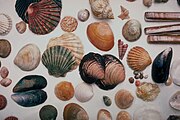



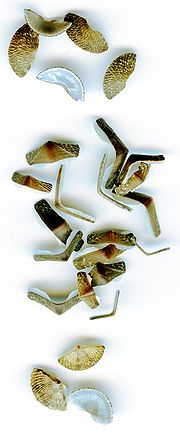




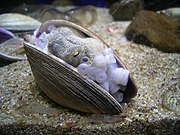
















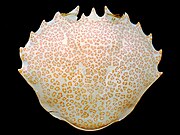




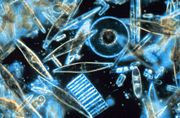

No comments:
Post a Comment